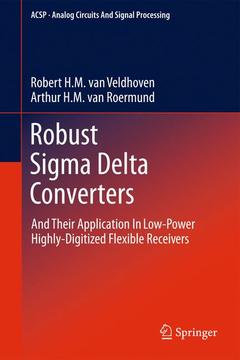Robust Sigma Delta Converters, 2011 And Their Application in Low-Power Highly-Digitized Flexible Receivers Analog Circuits and Signal Processing Series

Sigma Delta converters are a very popular choice for the A/D converter in multi-standard, mobile and cellular receivers. Key A/D converter specifications are high dynamic range, robustness, scalability, low-power and low EMI. Robust Sigma Delta Converters presents a requirement derivation of a Sigma Delta modulator applied in a receiver for cellular and connectivity, and shows trade-offs between RF and ADC. The book proposes to categorize these requirements in 5 quality indicators which can be used to qualify a system, namely accuracy, robustness, flexibility, efficiency and emission. In the book these quality indicators are used to categorize Sigma Delta converter theory. A few highlights on each of these quality indicators are;
- Quality indicators: provide a means to quantify system quality.
- Accuracy: introduction of new Sigma Delta Modulator architectures.
- Robustness: a significant extension on clock jitter theory based on phase and error amplitude error models. Extension of the theory describing aliasing in Sigma Delta converters for different types of DACs in the feedback loop.
- Flexibility: introduction of a Sigma Delta converter bandwidth scaling theory leading to very flexible Sigma Delta converters.
- Efficiency: introduction of new Figure-of-Merits which better reflect performance-power trade-offs.
- Emission: analysis of Sigma Delta modulators on emission is not part of the book
The quality indicators also reveal that, to exploit nowadays advanced IC technologies, things should be done as much as possible digital up to a limit where system optimization allows reducing system margins. At the end of the book Sigma Delta converter implementations are shown which are digitized on application-, architecture-, circuit- and layout-level.
Robust Sigma Delta Converters is written under the assumption that the reader has some background in receivers and in A/D conversion.
List of abbreviations.- Terminology.- List of symbols.- Nomenclature.- 1 Introduction.- 2 System quality indicators.- 3 Integrated receiver architectures for cellular and connectivity.- 4 Specifications for A/D converters in cellular and connectivity receivers.- 5 SD modulator algorithmic accuracy.- 6 SD modulator robustness.- 7 SD modulator flexibility.- 8 SD modulator efficiency.- 9 SD modulator implementations and the quality indicators.- 10 Conclusions.- A Harmonic and intermodulation distortion in an I&Q system.- B Distortion of a differential input transistor pair biased in weak inversion.- C Fourier series expansion and return-to-zero.- D Clock jitter in an I&Q system according to the TPJE clock jitter model.- References.- Index.
.Robert H.M. van Veldhoven was born in Eindhoven, The Netherlands, in 1972. After finishing his pre-education (HAVO) at ''Het Hertog-Jan College'' in Valkenswaard, he started to study ''hands-on'' electronics at the MTS ''Leonardo Da Vinci college'' in Eindhoven. After 2 years at the MTS, he started studying electrical engineering at the polytechnical college ''Fontys Hogescholen'' in Eindhoven. In 1996 he joined the Mixed-Signal Circuits and Systems group at Philips Research after successfully finishing his graduation project on a low-power Sigma Delta modulator for multi-meter applications. After working 3 years at Philips he started to pursue a master degree in Electronics from the Technical University of Eindhoven, which he successfully finished in 2003. After working for 10 years at Philips Research, he joined the Mixed-Signal Circuits and Systems group at NXP Semiconductor Research in Eindhoven in 2006, where he is an expert in the field of high-resolution A/D and D/A converters, and integrated circuits for instrumentation-, sensor-, audio-, and radio-systems. In 2010 he pursued a PhD degree in Electronic Engineering. Van Veldhoven holds various US patents and published various papers at leading conferences and in leading journals, and is reviewer for several professional journals and conferences. In 2004 and 2010, he was invited to give a forum presentation at the ISSCC about \sd modulators for wireless and cellular receivers.
Arthur H.M. van Roermund (SM’95) was born in Delft, The Netherlands in 1951. He received the M.Sc. degree in electrical engineering in 1975 from the Delft University of Technology and the Ph.D. degree in Applied Sciences from the K.U.Leuven, Belgium, in 1987. From 1975 to 1992 he was with Philips Research Laboratories in Eindhoven. From 1992 to 1999 he has been a full professor at the Electrical Engineering Department of Delft University of Technology, where he was chairman of the Electronics Research Gr
Date de parution : 04-2013
Ouvrage de 296 p.
15.5x23.5 cm
Disponible chez l'éditeur (délai d'approvisionnement : 15 jours).
Prix indicatif 157,74 €
Ajouter au panierDate de parution : 02-2011
Ouvrage de 296 p.
15.5x23.5 cm
Disponible chez l'éditeur (délai d'approvisionnement : 15 jours).
Prix indicatif 168,79 €
Ajouter au panier

